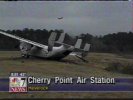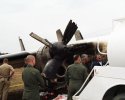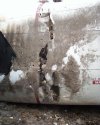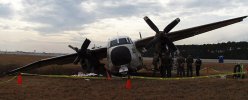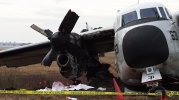I am currently an instructor at VAW-120 flying C-2A Greyhounds. I am a fleet experienced aviator with almost 1,600 flight hours, 200 carrier landing from the left seat (40 at night), another 300 carrier landings from the right seat, and was very confident in the cockpit of the C-2A.
Back on 12 March of this year, I was instructing a T-6 (landing pattern hop with emphasis on simulated single engine landings) with a student at MCAS Cherry Point. The entire hop had been done by the book. I spent the majority of my time instructing while keeping an eye out for the safety of the aircraft and crew. This student was doing well but I never let my gaurd down. He had some issues with his first SSE but on his second, did very well. Overall, the student was definitely doing above average. On his third SSE approach, I made two mistakes that ended up being the cause of a Class A mishap (over 1 million in damage but fortunetly no loss of human life).
To make it brief, the student flew this pass well, had his procedures down, rolled onto final on centerline, onspeed, and in coordinated flight. On touchdown, he rolled through the landing gear, as briefed, and I told him he could have both engines back. My first mistake of the flight was not to have my feet on the rudders on this particular pass. Granted I was in a good defensive position (left hand right behind the power levers, right hand on the glare shield, but opted to put my feet on the floor). If I had my feet on the rudders, I most likely would have known that the student had trimmed the rudder full left and was holding in right rudder with his right foot. As he got the right engine back, he matched the power levers, began to add power but for whatever reason, he relaxed his right foot and let off the rudder. He should have kept right rudder pressure; well, he actually should have increased it while adding power. My second mistake happend here, as soon as the aircraft started a slight yaw to the left, which I have seen many times, I was going to give him a potato to see if he would correct. Unfortunetly, the moment I had that thought, the aircraft started a viloent yaw to the left, with the left wing dropping. The aircraft departed the runway, hit the ground hard, spun almost 150 degrees off course (in the air mind you), hit the ground hard and came to a stop. From going straight down the runway to departing it at 90 degrees took ~1.7 seconds; it happened quick due to the asymmetric wing stall. The C-2 burst into flames on the right side, with the gear collapsing, the prop tearing through the fuselage, the right wing breaking in half, and the stbd bottom portion of the rudder shearing off. Thank you Grumman for that big wing that kept from flipping since it was going to go over on its back but obviously that huge wingspan prevented it. Once stopped, I called for an evacuation of the aircrew (5 total), shut down the engines, and told the stunned student to get out. I then exited the aircraft once all were out.
My FNAEB board is now over. I will fly and instruct again soon. Prior to this mishap, I was a steely eyed instructor with tons of confidence. I always felt I was ready for any situation. I had flown with much worse students than the one above and have had many worse situations. I was always able to come out of those situations unscathed. March 12 obviously was different. Again, from the investigation, all training was done by the book. Having your feet on the rudders isn't required by NATOPS, OPNAV 3710, VAW-120's SOP, or the STOP manual. However, it needed to happen to prevent this accident. I failed to do so and as the Aircraft Commander and Instructor Pilot of Greyhawk 631, I was responsible for the safety of the aircraft and crew. I failed to do my job on this flight. I didn't expect the unexpected. So please remember what we do is very unforgiving. Just when things seem 100% normal, all hell can break lose. I thank God than none of my crew was seriously injured or killed. An aircraft can be fixed or replaced, a human life cannot.
As always, FLY NAVY

Back on 12 March of this year, I was instructing a T-6 (landing pattern hop with emphasis on simulated single engine landings) with a student at MCAS Cherry Point. The entire hop had been done by the book. I spent the majority of my time instructing while keeping an eye out for the safety of the aircraft and crew. This student was doing well but I never let my gaurd down. He had some issues with his first SSE but on his second, did very well. Overall, the student was definitely doing above average. On his third SSE approach, I made two mistakes that ended up being the cause of a Class A mishap (over 1 million in damage but fortunetly no loss of human life).
To make it brief, the student flew this pass well, had his procedures down, rolled onto final on centerline, onspeed, and in coordinated flight. On touchdown, he rolled through the landing gear, as briefed, and I told him he could have both engines back. My first mistake of the flight was not to have my feet on the rudders on this particular pass. Granted I was in a good defensive position (left hand right behind the power levers, right hand on the glare shield, but opted to put my feet on the floor). If I had my feet on the rudders, I most likely would have known that the student had trimmed the rudder full left and was holding in right rudder with his right foot. As he got the right engine back, he matched the power levers, began to add power but for whatever reason, he relaxed his right foot and let off the rudder. He should have kept right rudder pressure; well, he actually should have increased it while adding power. My second mistake happend here, as soon as the aircraft started a slight yaw to the left, which I have seen many times, I was going to give him a potato to see if he would correct. Unfortunetly, the moment I had that thought, the aircraft started a viloent yaw to the left, with the left wing dropping. The aircraft departed the runway, hit the ground hard, spun almost 150 degrees off course (in the air mind you), hit the ground hard and came to a stop. From going straight down the runway to departing it at 90 degrees took ~1.7 seconds; it happened quick due to the asymmetric wing stall. The C-2 burst into flames on the right side, with the gear collapsing, the prop tearing through the fuselage, the right wing breaking in half, and the stbd bottom portion of the rudder shearing off. Thank you Grumman for that big wing that kept from flipping since it was going to go over on its back but obviously that huge wingspan prevented it. Once stopped, I called for an evacuation of the aircrew (5 total), shut down the engines, and told the stunned student to get out. I then exited the aircraft once all were out.
My FNAEB board is now over. I will fly and instruct again soon. Prior to this mishap, I was a steely eyed instructor with tons of confidence. I always felt I was ready for any situation. I had flown with much worse students than the one above and have had many worse situations. I was always able to come out of those situations unscathed. March 12 obviously was different. Again, from the investigation, all training was done by the book. Having your feet on the rudders isn't required by NATOPS, OPNAV 3710, VAW-120's SOP, or the STOP manual. However, it needed to happen to prevent this accident. I failed to do so and as the Aircraft Commander and Instructor Pilot of Greyhawk 631, I was responsible for the safety of the aircraft and crew. I failed to do my job on this flight. I didn't expect the unexpected. So please remember what we do is very unforgiving. Just when things seem 100% normal, all hell can break lose. I thank God than none of my crew was seriously injured or killed. An aircraft can be fixed or replaced, a human life cannot.
As always, FLY NAVY



